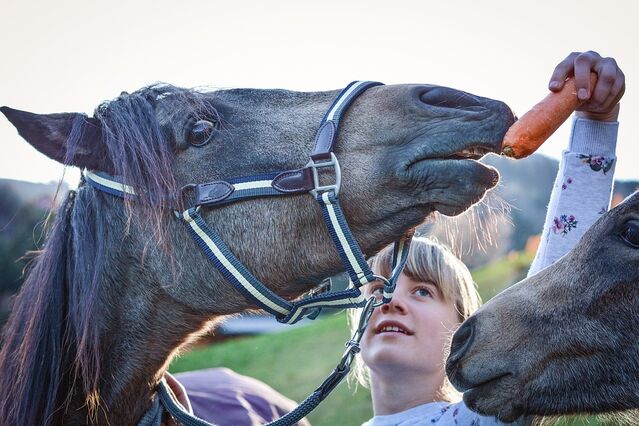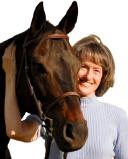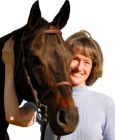Dopamine
New Ways of Using Food to Train Horses
Why should we limit food treats for animals who are trained by reward?
Posted February 11, 2022 Reviewed by Tyler Woods
Key points
- Reward is only half the story of positive reinforcement training—prediction is equally important.
- When it comes to neural activation, a key element of positive reinforcement is surprise.
- Frequent edible treats destroy surprise and waste your training power.
- Boost animal learning by using non-edible rewards most of the time and saving the surprise of food for the most critical lessons.

Welcome to the horse barn! Please put away the carrots and peppermints. Why? For your safety, the horse’s welfare, and the trainer’s power. Let me explain.
Food is a standard reward in positive reinforcement (PR) training because it is a primary reinforcer. No argument there, but I’ve found that horses benefit from a modified technique. This change is based on brain science that shows two components of a reward situation, both of which create neural activation that boosts learning in the brain. The first component is the reward itself. A powerful reward, like food, in the case of most animals, increases dopamine release. More dopamine leads to faster and longer-lasting learning. Standard PR training has been based on this principle for decades. Some PR trainers use treats so liberally that they offer gobs of treats in a short time span as the animal’s actions move toward the trainer’s goal.
Neuroscientists now know that the second component is equally critical—the animal’s prediction of a reward. A horse in the midst of learning a desired behavior comes to expect a particular type of reward—whatever the trainer has given it in the past. If this horse is fed a peppermint treat for each desired behavior, no matter how easy or difficult it is, it will come to expect that same peppermint treat each time. When you offer the same reward or less, neural activation plateaus and learning is not as strong. But when the reward is surprisingly good, neurons fire with greater strength, more dopamine is released, and learning ability soars.
A central element of training, then, is surprise. A horse that is accustomed to receiving edible treats as rewards soon comes to expect them. Usually, trainers who rely on edible treats serve up the same flavors, smells, and sizes of treats each time they reward. All of this means that a horse can quickly learn to predict exactly what is coming. When that happens, the element of surprise disappears.
To avoid spoiling the surprise, try training primarily by non-edible reward. Most of the time I use stroking, scratching, relaxation, a soothing tone, praise, a rest break, access to equine buddies, or the opportunity to play—just to name a few—to reward a horse for good behavior. Reliance on non-edible rewards causes dopamine release but still allows food to retain its excellent training power. I save edible treats for special performances, like a maneuver that goes against a horse’s nature, is very difficult to perform, or is something the horse has resisted in the past. Occasionally, I use yummies to get the horse’s initial attention when beginning to learn something new.
Training by reward works especially well when the horse’s prediction underestimates the outcome. My horses often expect a stroke or a kind gentle voice in return for good behavior. If I whip out a carrot instead, that’s like the Holy Grail! The horse is surprised to receive such a wonderful reward, and the behavior connected with it is remembered very well. In training, that’s exactly what we want.
Timing is critical in training by reward. Many people today ply their horses with indiscriminate treats—food that is given for no specific immediate behavior. Reward is connected in the brain with the most recent action that occurred. So, when horses perform a specific desired action, it must be reinforced in the next few seconds. Any later than that, and the horse has moved on to some other action that might not be desired at all.
To sum up, here's how to use the prediction component of reward-based neural activation for fast, effective learning:
- Limit the use of edible rewards for good behavior, so they create surprise.
- Alter the rare edible reward so that its flavor, smell, and level of goodness boost surprise.
- Select the most surprising rewards for the most difficult desired behaviors.
- Prohibit all indiscriminate treats; they waste your training power. If you must give the horse a carrot just for being cute, place it in his stall or feeder when he is not there.
- Use non-edible rewards liberally; mix and match them to achieve the level of value you want.
- Reward, but don’t lure. A reward is offered only after the desired behavior occurs; a lure is available and known to the horse before or during the behavior. Lures destroy the element of surprise.
- Be sure every reward—edible and non-edible—is offered within a few seconds of the desired behavior.
Try using this brain-based strategy of training by reward for a few months, and see what you think.


